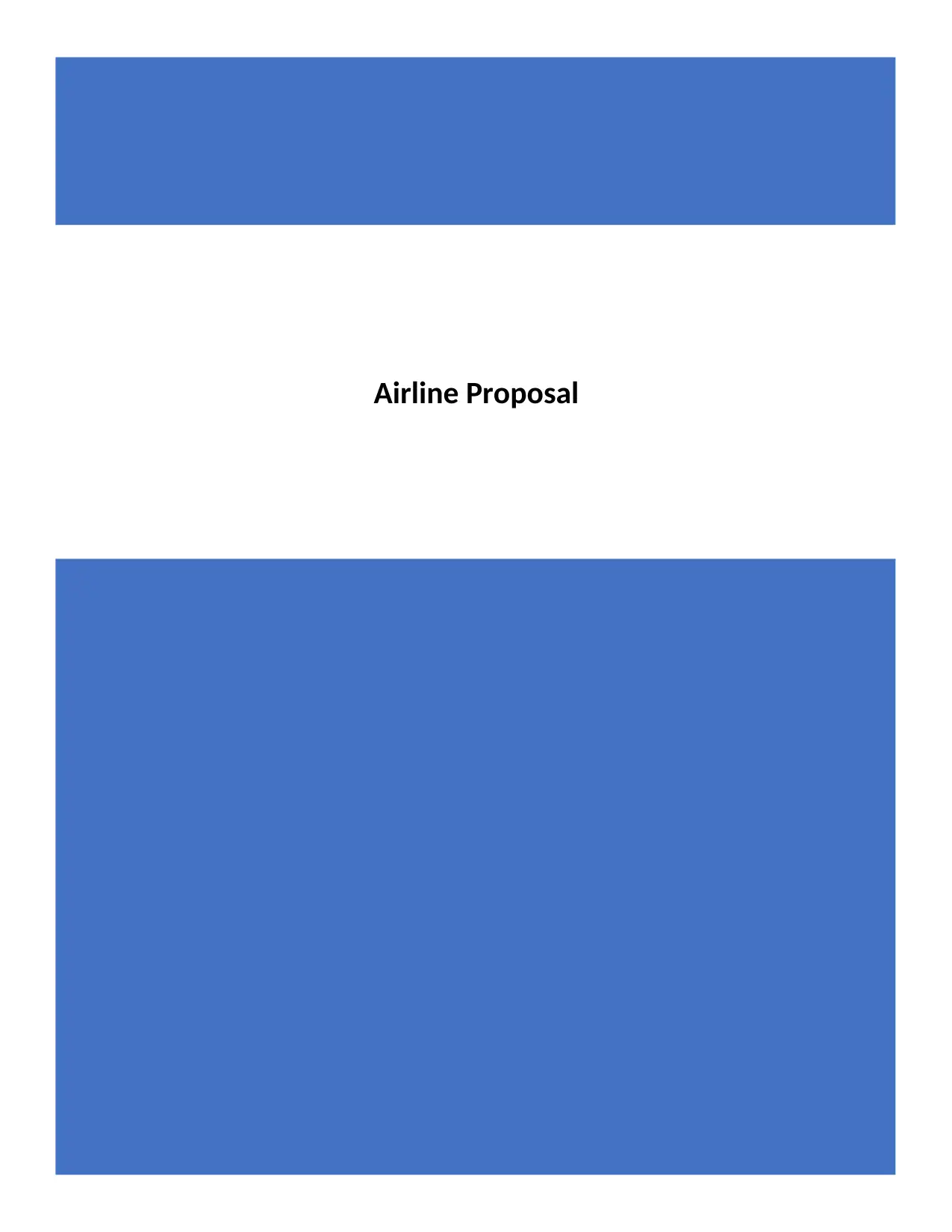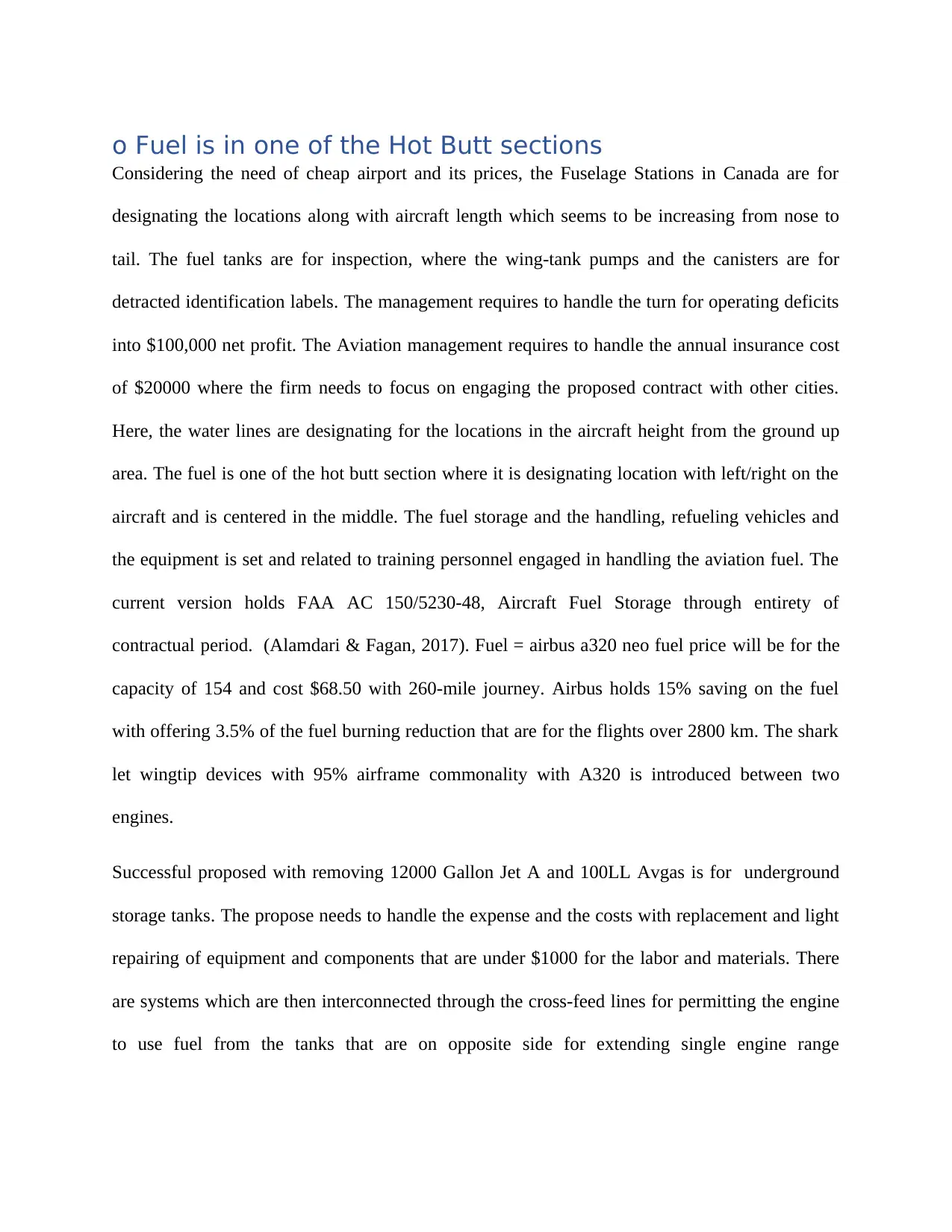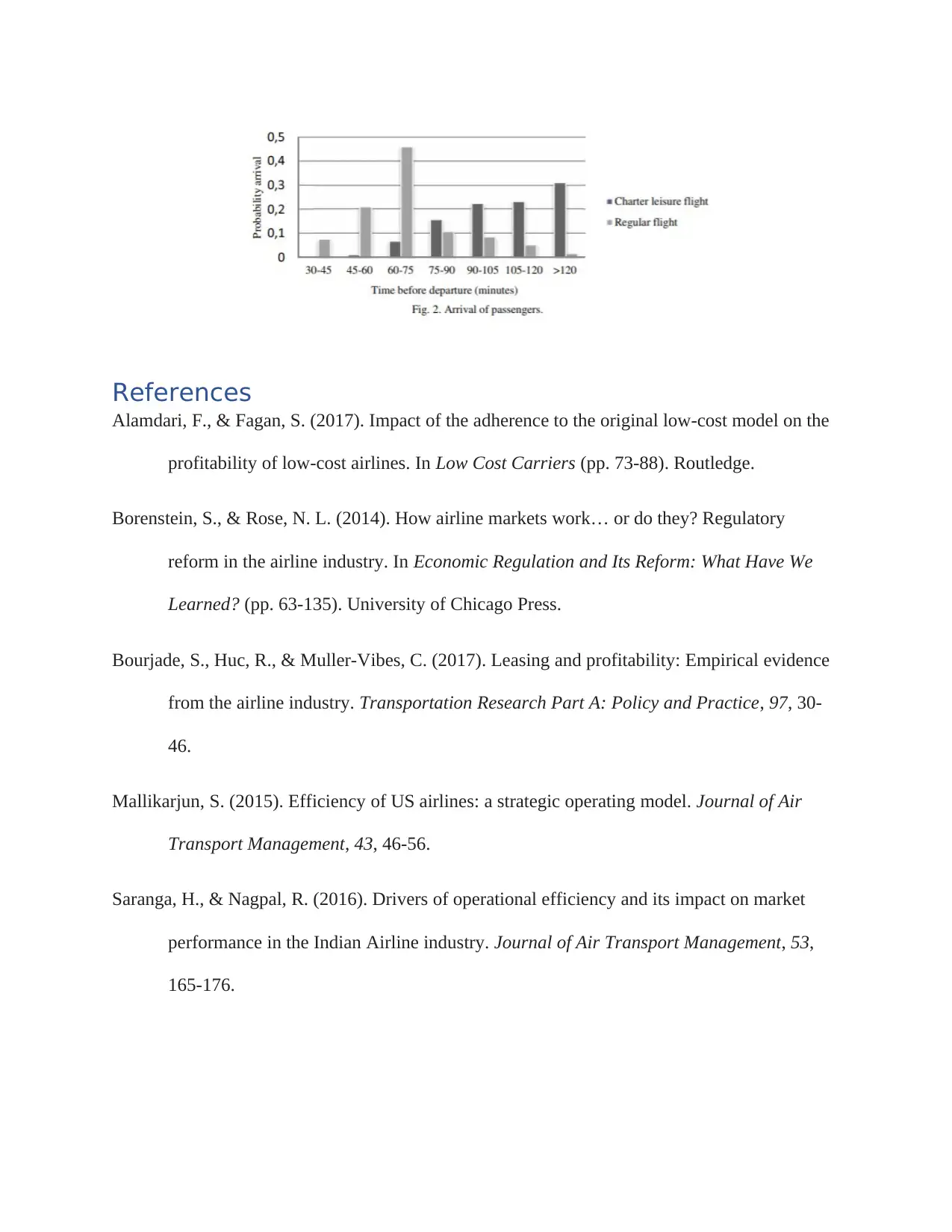Airline Proposal: Fuel, Ground Cost, Airport Location, Regional Capacity
VerifiedAdded on 2023/05/29
|8
|1434
|428
AI Summary
This proposal discusses the a fuel storagend handling, ground costs, airport location, and regional capacity for an ultra-low-cost airline in Canada. It includes references to studies on airline profitability and efficiency.
Contribute Materials
Your contribution can guide someone’s learning journey. Share your
documents today.

Airline Proposal
Secure Best Marks with AI Grader
Need help grading? Try our AI Grader for instant feedback on your assignments.

Contents
o Fuel is in one of the Hot Butt sections..........................................................................................1
o Ground Cost..................................................................................................................................1
o Airport is located on the Pearson International Airport site.........................................................2
o Regional Capacity.........................................................................................................................3
References........................................................................................................................................3
o Fuel is in one of the Hot Butt sections..........................................................................................1
o Ground Cost..................................................................................................................................1
o Airport is located on the Pearson International Airport site.........................................................2
o Regional Capacity.........................................................................................................................3
References........................................................................................................................................3

o Fuel is in one of the Hot Butt sections
Considering the need of cheap airport and its prices, the Fuselage Stations in Canada are for
designating the locations along with aircraft length which seems to be increasing from nose to
tail. The fuel tanks are for inspection, where the wing-tank pumps and the canisters are for
detracted identification labels. The management requires to handle the turn for operating deficits
into $100,000 net profit. The Aviation management requires to handle the annual insurance cost
of $20000 where the firm needs to focus on engaging the proposed contract with other cities.
Here, the water lines are designating for the locations in the aircraft height from the ground up
area. The fuel is one of the hot butt section where it is designating location with left/right on the
aircraft and is centered in the middle. The fuel storage and the handling, refueling vehicles and
the equipment is set and related to training personnel engaged in handling the aviation fuel. The
current version holds FAA AC 150/5230-48, Aircraft Fuel Storage through entirety of
contractual period. (Alamdari & Fagan, 2017). Fuel = airbus a320 neo fuel price will be for the
capacity of 154 and cost $68.50 with 260-mile journey. Airbus holds 15% saving on the fuel
with offering 3.5% of the fuel burning reduction that are for the flights over 2800 km. The shark
let wingtip devices with 95% airframe commonality with A320 is introduced between two
engines.
Successful proposed with removing 12000 Gallon Jet A and 100LL Avgas is for underground
storage tanks. The propose needs to handle the expense and the costs with replacement and light
repairing of equipment and components that are under $1000 for the labor and materials. There
are systems which are then interconnected through the cross-feed lines for permitting the engine
to use fuel from the tanks that are on opposite side for extending single engine range
Considering the need of cheap airport and its prices, the Fuselage Stations in Canada are for
designating the locations along with aircraft length which seems to be increasing from nose to
tail. The fuel tanks are for inspection, where the wing-tank pumps and the canisters are for
detracted identification labels. The management requires to handle the turn for operating deficits
into $100,000 net profit. The Aviation management requires to handle the annual insurance cost
of $20000 where the firm needs to focus on engaging the proposed contract with other cities.
Here, the water lines are designating for the locations in the aircraft height from the ground up
area. The fuel is one of the hot butt section where it is designating location with left/right on the
aircraft and is centered in the middle. The fuel storage and the handling, refueling vehicles and
the equipment is set and related to training personnel engaged in handling the aviation fuel. The
current version holds FAA AC 150/5230-48, Aircraft Fuel Storage through entirety of
contractual period. (Alamdari & Fagan, 2017). Fuel = airbus a320 neo fuel price will be for the
capacity of 154 and cost $68.50 with 260-mile journey. Airbus holds 15% saving on the fuel
with offering 3.5% of the fuel burning reduction that are for the flights over 2800 km. The shark
let wingtip devices with 95% airframe commonality with A320 is introduced between two
engines.
Successful proposed with removing 12000 Gallon Jet A and 100LL Avgas is for underground
storage tanks. The propose needs to handle the expense and the costs with replacement and light
repairing of equipment and components that are under $1000 for the labor and materials. There
are systems which are then interconnected through the cross-feed lines for permitting the engine
to use fuel from the tanks that are on opposite side for extending single engine range

(Mallikarjun, 2015).
o Ground Cost
In Canada, the air market holds the ultra-low-cost airline where it focuses only on handling the
high taxes and fees, sparse population and the other restrictions on a foreign ownership. The
tracking, measuring and then benchmarking the costs is important and useful where the driver-
based benchmark help the carriers to work on complementing a higher peer (Borenstein & Rose,
2014).
The quantified approach is to handle the new inflight service processes with catering that it helps
to free up the crew member per flight.
The operating costs for the aircraft with per block hour will be $2550 for 185 seat for B757-200.
The average service cost with the aircraft departure passenger in average of $800. The indirect
and the system overhead costs are for the operating expense which is average 13%.
o Ground Cost
In Canada, the air market holds the ultra-low-cost airline where it focuses only on handling the
high taxes and fees, sparse population and the other restrictions on a foreign ownership. The
tracking, measuring and then benchmarking the costs is important and useful where the driver-
based benchmark help the carriers to work on complementing a higher peer (Borenstein & Rose,
2014).
The quantified approach is to handle the new inflight service processes with catering that it helps
to free up the crew member per flight.
The operating costs for the aircraft with per block hour will be $2550 for 185 seat for B757-200.
The average service cost with the aircraft departure passenger in average of $800. The indirect
and the system overhead costs are for the operating expense which is average 13%.
Secure Best Marks with AI Grader
Need help grading? Try our AI Grader for instant feedback on your assignments.

Hence, the driver-based costs analysis is done by the channels through cheap online sales which
is accounting for low shares of bookings (Bourjade, Huc, & Muller-Vibes, 2017). The costs are
defined with focusing on the disaggregation of total airline costs, where the air carrier and the
general aviation is set either variable or fixed. The proportions for the aircraft usage includes fuel
and oil, crew costs that holds little or no change in proportion to change in activity. There are
fixed costs which show a little or no change in proportion to changes in activities.
o Airport location
The location of the Airport site holds the largest area where there are different cargo and
maintenance facilities on a site, and it is on the site of Coast services. With the fuselage and the
airframe, there are designing that are seen to be done mechanically which is operated by the
four-position handle. The cost of the fuel is not only for taking a huge chunk that is out of the
airline revenue as well. Hence, the airline bottom line, maintenance costs and the fees that is paid
to the airports need to be considered and calculated. The airline industry in this region holds
main control tower with the infield operational area (Saranga & Nagpal, 2016). In Canada, there
are Traffic Management Unit to work on cargo facilities that are set through warehouse space,
and the maintenance and routine aircraft inspections are also done. U.S airline industry is
is accounting for low shares of bookings (Bourjade, Huc, & Muller-Vibes, 2017). The costs are
defined with focusing on the disaggregation of total airline costs, where the air carrier and the
general aviation is set either variable or fixed. The proportions for the aircraft usage includes fuel
and oil, crew costs that holds little or no change in proportion to change in activity. There are
fixed costs which show a little or no change in proportion to changes in activities.
o Airport location
The location of the Airport site holds the largest area where there are different cargo and
maintenance facilities on a site, and it is on the site of Coast services. With the fuselage and the
airframe, there are designing that are seen to be done mechanically which is operated by the
four-position handle. The cost of the fuel is not only for taking a huge chunk that is out of the
airline revenue as well. Hence, the airline bottom line, maintenance costs and the fees that is paid
to the airports need to be considered and calculated. The airline industry in this region holds
main control tower with the infield operational area (Saranga & Nagpal, 2016). In Canada, there
are Traffic Management Unit to work on cargo facilities that are set through warehouse space,
and the maintenance and routine aircraft inspections are also done. U.S airline industry is

working on handling the restricting of the economic value report where there are reduced
demands for the air travel, where the pricing for the jet fuels are increased to handle the near
record levels. The airline reduced capacity with the retired fuel inefficiency have maintained a
major focus on the profitability standards. Hence, there are direct and indirect expenses for the
air carriers which includes direct costs that are for examining about different perspectives of
carrier costs. U.S. airlines work on handling the operating costs with incremental forms that
different from average costs as well (Zhang, Yang, Wang & Zhang, 2014).
o Regional Capacity
The regional capacity for the operations is mainly to provide the passenger proper air services to
communities without proper demands to attract mainly the mainline services. There are
possibilities that the annual passenger traffic is seen to be below 700000 and then this will lack
the prospects for the growth due to the catch areas. The airport service could have limitations for
regular routes and the charter leisure flights, where approximately 18 airports or more can serve
10000 to 700000 passengers. The high population of regional airport catchment areas are the
success key. The regional airport is offering traffic with air cargo and then enlarging catchment
areas for road feeder system. (Treanor, Simkins, Rogers & Carter, 2014). The regional airports
could be used as:
a. The passengers are arriving in a time with the period that is of 1h 25 minutes. This follow
the time of working for check-in from 2 hours to 35 minutes before the departure.
b. The passengers are limited with seat numbers.
c. The passengers are arriving for different numbers in groups and the local transfer like bus
and the passengers could be handled by tour operator.
demands for the air travel, where the pricing for the jet fuels are increased to handle the near
record levels. The airline reduced capacity with the retired fuel inefficiency have maintained a
major focus on the profitability standards. Hence, there are direct and indirect expenses for the
air carriers which includes direct costs that are for examining about different perspectives of
carrier costs. U.S. airlines work on handling the operating costs with incremental forms that
different from average costs as well (Zhang, Yang, Wang & Zhang, 2014).
o Regional Capacity
The regional capacity for the operations is mainly to provide the passenger proper air services to
communities without proper demands to attract mainly the mainline services. There are
possibilities that the annual passenger traffic is seen to be below 700000 and then this will lack
the prospects for the growth due to the catch areas. The airport service could have limitations for
regular routes and the charter leisure flights, where approximately 18 airports or more can serve
10000 to 700000 passengers. The high population of regional airport catchment areas are the
success key. The regional airport is offering traffic with air cargo and then enlarging catchment
areas for road feeder system. (Treanor, Simkins, Rogers & Carter, 2014). The regional airports
could be used as:
a. The passengers are arriving in a time with the period that is of 1h 25 minutes. This follow
the time of working for check-in from 2 hours to 35 minutes before the departure.
b. The passengers are limited with seat numbers.
c. The passengers are arriving for different numbers in groups and the local transfer like bus
and the passengers could be handled by tour operator.

References
Alamdari, F., & Fagan, S. (2017). Impact of the adherence to the original low-cost model on the
profitability of low-cost airlines. In Low Cost Carriers (pp. 73-88). Routledge.
Borenstein, S., & Rose, N. L. (2014). How airline markets work… or do they? Regulatory
reform in the airline industry. In Economic Regulation and Its Reform: What Have We
Learned? (pp. 63-135). University of Chicago Press.
Bourjade, S., Huc, R., & Muller-Vibes, C. (2017). Leasing and profitability: Empirical evidence
from the airline industry. Transportation Research Part A: Policy and Practice, 97, 30-
46.
Mallikarjun, S. (2015). Efficiency of US airlines: a strategic operating model. Journal of Air
Transport Management, 43, 46-56.
Saranga, H., & Nagpal, R. (2016). Drivers of operational efficiency and its impact on market
performance in the Indian Airline industry. Journal of Air Transport Management, 53,
165-176.
Alamdari, F., & Fagan, S. (2017). Impact of the adherence to the original low-cost model on the
profitability of low-cost airlines. In Low Cost Carriers (pp. 73-88). Routledge.
Borenstein, S., & Rose, N. L. (2014). How airline markets work… or do they? Regulatory
reform in the airline industry. In Economic Regulation and Its Reform: What Have We
Learned? (pp. 63-135). University of Chicago Press.
Bourjade, S., Huc, R., & Muller-Vibes, C. (2017). Leasing and profitability: Empirical evidence
from the airline industry. Transportation Research Part A: Policy and Practice, 97, 30-
46.
Mallikarjun, S. (2015). Efficiency of US airlines: a strategic operating model. Journal of Air
Transport Management, 43, 46-56.
Saranga, H., & Nagpal, R. (2016). Drivers of operational efficiency and its impact on market
performance in the Indian Airline industry. Journal of Air Transport Management, 53,
165-176.
Paraphrase This Document
Need a fresh take? Get an instant paraphrase of this document with our AI Paraphraser

Treanor, S. D., Simkins, B. J., Rogers, D. A., & Carter, D. A. (2014). Does operational and
financial hedging reduce exposure? Evidence from the US airline industry. Financial
Review, 49(1), 149-172.
Zhang, Q., Yang, H., Wang, Q., & Zhang, A. (2014). Market power and its determinants in the
Chinese airline industry. Transportation Research Part A: Policy and Practice, 64, 1-13.
financial hedging reduce exposure? Evidence from the US airline industry. Financial
Review, 49(1), 149-172.
Zhang, Q., Yang, H., Wang, Q., & Zhang, A. (2014). Market power and its determinants in the
Chinese airline industry. Transportation Research Part A: Policy and Practice, 64, 1-13.
1 out of 8
Your All-in-One AI-Powered Toolkit for Academic Success.
+13062052269
info@desklib.com
Available 24*7 on WhatsApp / Email
![[object Object]](/_next/static/media/star-bottom.7253800d.svg)
Unlock your academic potential
© 2024 | Zucol Services PVT LTD | All rights reserved.